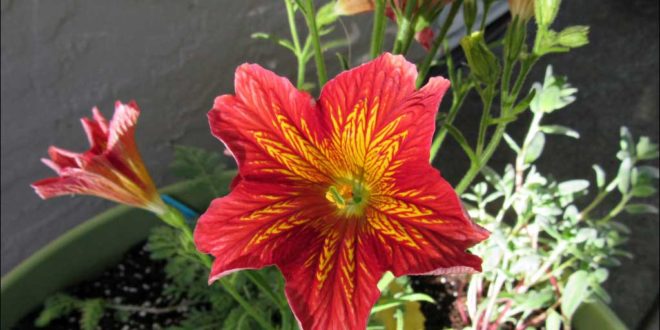Salpiglossis: a name that just rolls off the tongue. Which it should since the genus name comes from the Greek words sappinx meaning trumpet and glossa meaning tongue with reference to the elongated trupet-shaped flowers. It is a spectacular flower. I don’t know how I missed this flower over the years.
Many salpiglossis are hybrid cultivars that are primarily derived from Salpiglossis sinuata. They are upright annuals that grow to 1.5-3’ tall on somewhat weak stems clad with lanceolate green leaves (to 4” long) with wavy margins. Leaves and stems are typically hairy and sticky. Funnel-shaped, wide-throated, 5-lobed flowers (to 2” wide) in clusters bloom from the upper leaf axils in the cool temperatures of late spring to early summer, with continued bloom throughout summer usually occurring only in cool summer areas. Flower colors typically include shades of red, orange, yellow, bronze, violet or purple, usually with marbling or contrasting veins in different colors.
Plant painted tongue in fertile, well-drained soil. Although it benefits from full to partial sunlight, the plant won’t bloom in high temperatures. A location in afternoon shade is helpful in hot climates. You should also provide a thin layer of mulch to keep the roots cool and moist.
Growing Salpiglossis from Seed
Plant Salpiglossis seeds directly in the garden after the soil is warm and all danger of frost has passed. Sprinkle the tiny seeds on the surface of the soil, then cover the area with cardboard because the seeds germinate in darkness. Remove the cardboard as soon as the seeds sprout, which usually takes two to three weeks. Alternatively, plant Salpiglossis seeds indoors in late winter, about ten to 12 weeks before the last frost. Peat pots work well and prevent damage to the roots when the seedlings are transplanted outdoors. Cover the pots with black plastic to provide darkness until the seeds germinate. Water as needed to keep the potting mix slightly moist. If you don’t relish the idea of planting seeds, look for this plant at most garden centers.
Salpiglossis Care
Thin Salpiglossis plants when the seedlings are about 4 inches tall. This is also a good time to pinch the tips of young plants to encourage bushy, compact growth. Water this drought-tolerant plant only when the top 2 inches of soil are dry. Never let the soil become soggy. Twice-monthly feeding with a regular, water-soluble garden fertilizer diluted to half strength provides nutrition the plant requires to produce blooms. Deadhead spent blooms to promote more blooms. If necessary, tuck a wooden stake or branch into the soil to provide extra support. Salpigloss tends to be pest-resistant, but spray the plant with insecticidal soap if you notice aphids.
First planted: 2017
Nursery: Yamagami of Cupertino








